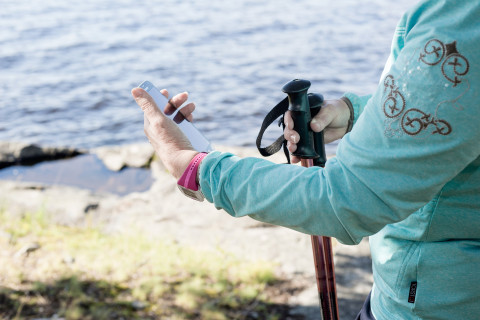Finnish StopDia study yielded promising preliminary results in reducing the risk of type 2 diabetes. Lifestyle guidance in a group and application that supports the adoption of healthy lifestyle habits helped StopDia participants to reduce their waist circumference and improve their dietary habits. For example, their fruit and vegetable consumption increased.
"Using the BitHabit application that supports the adoption of healthy lifestyles for a year combined with group guidance improved the diets of the participants and narrowed their waist circumference. These preliminary results are promising and encourage us to continue the development and use of the model," says Professor Timo Lakka, Co-Principal Investigator of the StopDia study, from University of Eastern Finland.
The purpose of the BitHabit application is to automate the adoption of new habits and to generate a sustainable behaviour change. The application allowed the participants to make healthy choices that suited them, and tick them as accomplished.
The new habit may be e.g. taking healthy snacks to eat between meals at work so that hunger in the afternoon does not cause fatigue and unhealthy choices.
"Surprisingly, the application was used more actively by the older participants. In other words, it is worthwhile to offer digital alternatives to people in an unprejudiced manner, regardless of their age," explains Marja Harjumaa, Senior Scientist at VTT Technical Research Centre of Finland, who is involved in the development of the application.
The study showed that the Finnish Diabetes Risk Score (FINDRISC), the most widely used risk test for type 2 diabetes in the world, effectively identified people at increased risk without laboratory testing.
More than half of the StopDia participants with an elevated FINDRISC score in the digital screening already had a glucose metabolism disorder. In addition, five per cent were diagnosed with previously undetected diabetes. The study also revealed that healthcare reaches only a small proportion of people who would benefit from preventive activities.
The best way to reach people and get them involved in the study was through social media and the editorial content of newspapers. In particular, journalistic articles with personal interviews brought vast numbers of people to the risk screening website. The visibility acquired through social media, on the other hand, is mostly subject to a charge. In any case, to be successful, informing still requires contents that the target group finds interesting.
"Men traditionally are less interested to take part in health promotion campaigns and studies. Their participation was most effectively promoted by a word from a friend or a relative. Many men pointed out that 'the wife urged me to come'," says Jaana Lindström, Research Manager and developer of the FINDRISC test.
In StopDia, the information disseminated in workplaces reached women in particular.
The StopDia study examined how to reduce the risk of type 2 diabetes not only by providing individual lifestyle support but also by targeting the living environment and at the level of society. Environment has a powerful impact on decision-making and behaviour. Decisions are only partly based on conscious deliberation. A great deal of daily choices occur automatically - often unnoticed.
The StopDia at Work study aimed at altering the choice architecture of working environments to facilitate healthy dietary choices and physical activity at the workplace. This approach, also known as nudging, differs from the more conventional methods used for promoting wellbeing at work, such as campaigns and sports benefits.
Preliminary results suggest that the consumption of vegetables, fruit and nuts during working hours among the employees of participating workplaces was greater at the end of the study compared to the beginning of the study. No difference was observed in the consumption of savoury and sweet delicacies. Performing restoring break exercise, such as stretching, was also more common at the end of the study.
The Stop Diabetes (StopDia) study is funded by the Strategic Research Council (SRC), operating in conjunction with the Academy of Finland. The project is part of the Health, Welfare and Lifestyles (HEALTH) programme that ended this year. The study was conducted by the University of Eastern Finland, the National Institute for Health and Welfare (THL) and VTT in collaboration with local and regional authorities, and regional healthcare operators (e.g. the Päijänne Tavastia Joint Municipal Authority for Welfare, Eksote, Ylä-Savon SOTE Joint Municipal Authority, the city of Varkaus, the city of Kuopio, and the municipalities of Siilinjärvi and Joroinen). There were also more than 20 societal operators involved in the activities, including such organisations as the Finnish Diabetes Association and the Finnish Heart Association, as well as approximately 40 employers.
These preliminary results of the study are published at StopDia National Seminar on 21 August.
Contact information
Jussi Pihlajamäki
Dean
Principal Investigator, StopDia project
Faculty of Health Sciences
University of Eastern Finland
[email protected]
+358 50 344 01 87
Jaana Lindström
Research Manager
Department of Public Health Solutions
THL
[email protected]
+358 29 524 8635
Marja Harjumaa
Senior scientist
Data-driven solutions
VTT
[email protected]
+358 44 515 9439
